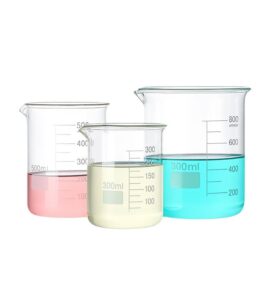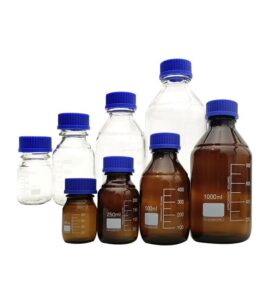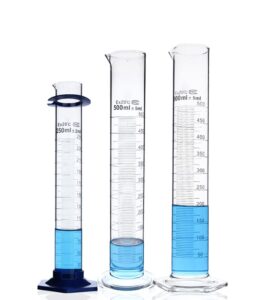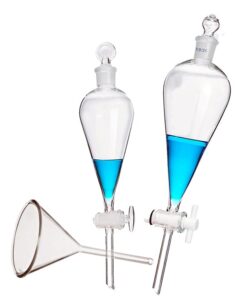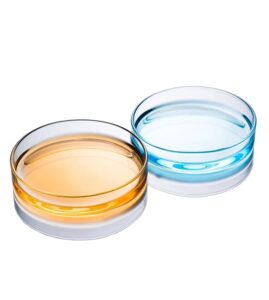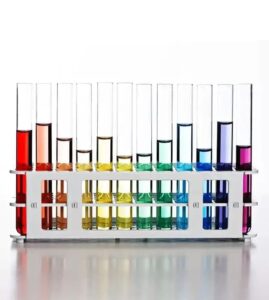Have you ever wondered about the humble test tube, often seen in the clutches of white-coated scientists in movies? What secrets do these simple glass cylinders hold? How have they become such an integral part of the scientific world?
Test tubes, a staple in any laboratory, are more than just glassware. They’re crucial tools in the journey of scientific discovery. In this article, we’ll delve into the various roles test tubes play in research, from holding substances to facilitating complex reactions.
Stay with us as we explore the intriguing world of test tubes.
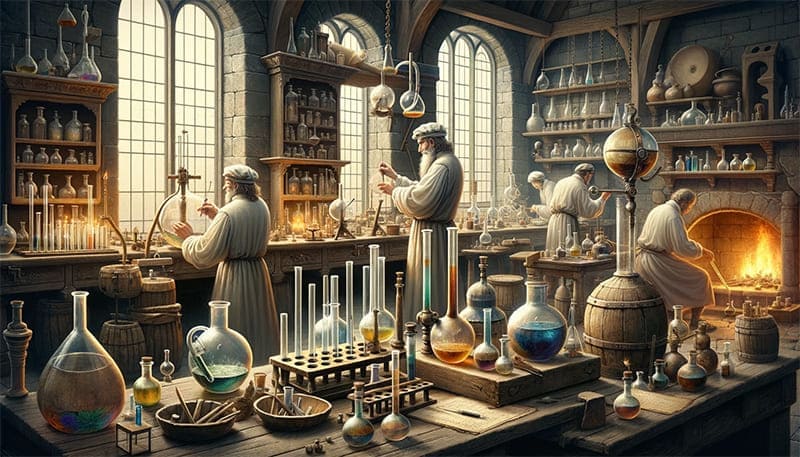
Historical Development of Test Tubes
Understanding the historical development of test tubes offers fascinating insight into their evolution from simple glass tubes to sophisticated tools of modern science. This journey reflects the progress of scientific inquiry and technological advancements.
The Origins
The origins of the test tube can be traced back to the early days of alchemy and chemistry. Initially, alchemists used a variety of glassware, including vials and flasks, for their experiments. The transition to a more standardized tube shape likely occurred in the late 17th or early 18th century, paralleling the development of modern chemistry.
Early Uses and Glass Blowing Techniques
In the early stages, test tubes were primarily used for basic chemical reactions and as containers for various substances. The art of glass blowing played a crucial role in their production. Skilled artisans crafted these tubes, which were prone to inconsistencies and fragility due to the limitations of the techniques and materials available at the time.
Advancements in Glass Technology
The 19th and 20th centuries saw significant advancements in glass technology. The development of borosilicate glass, known for its durability and resistance to thermal shock, was a major milestone. This innovation made test tubes more reliable and safer for use in heating and cooling processes, thus expanding their application in various scientific experiments.
Standardization and Mass Production
With the rise of industrialization, the mass production and standardization of test tubes became possible. This allowed for greater uniformity in size and shape, making experiments more consistent and repeatable. It also made test tubes more accessible to laboratories around the world.
Diversification in Materials
In the latter half of the 20th century, the introduction of plastic test tubes provided an alternative to glass. These plastic tubes, made from materials like polypropylene and polystyrene, offered advantages in terms of cost, durability, and versatility. They became particularly useful in biological and medical research where disposability and sterility were key factors.
Modern Test Tubes and Future Innovations
Today, test tubes continue to evolve with advancements in materials science and technology. We are seeing the development of test tubes with integrated sensors and smart capabilities, catering to the needs of increasingly sophisticated and automated laboratories.
From their humble beginnings to their current status as indispensable tools in scientific research, the history of test tubes mirrors the growth of science itself. They have adapted and evolved, reflecting the changing needs and expanding possibilities of scientific experimentation. As we look to the future, test tubes will undoubtedly continue to be a fundamental part of the scientific toolkit, evolving alongside the fields they serve.
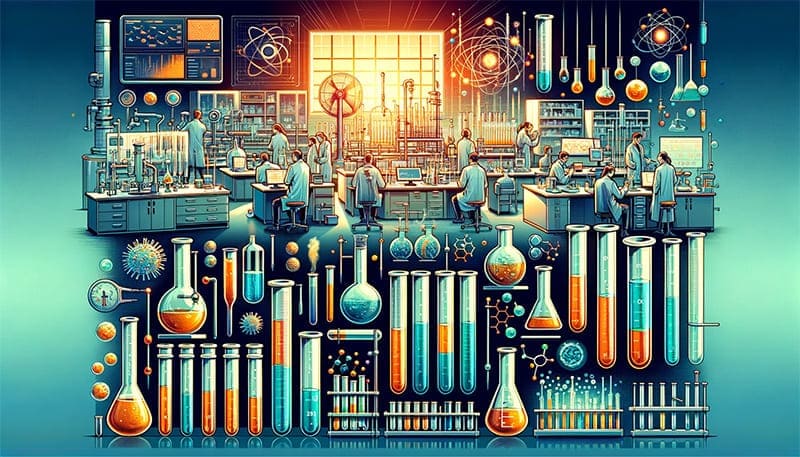
What are Test Tubes Used For in Research?
Test tubes are versatile. They are primarily used for holding liquids or solids like acids, bases, salts, and reagent powders. Their simplicity belies their importance in research, where precise measurements and controlled conditions are paramount.
Here are the main functions of a test tube:
- Holding Liquids or Solid Reagents: Test tubes are used to hold liquid reagents such as acids, bases, and salts, as well as solid reagents like powder and granules.
- Heating Small Amounts of Solids or Liquids: They are used for heating small amounts of solids or liquids, for example, heating catalysts or reactants in chemical reactions.
- Generating Small Amounts of Gas: Test tubes can serve as reactors for generating small amounts of gas, such as producing hydrogen gas from the reaction of zinc granules with dilute hydrochloric acid.
- Collecting Small Amounts of Gas: They are also used for collecting small amounts of gas, for instance, in gas analysis to collect gas samples.
- Dissolving Small Amounts of Gases, Liquids, or Solids: Test tubes are suitable for dissolving small amounts of gases, liquids, or solids, like dissolving metallic sodium in chemical experiments.
- Container for Centrifugation: They can be used as containers during centrifugation, such as separating organelles or proteins in biological labs.
- Reaction Container for Small Amounts of Reagents: Test tubes serve as reaction containers for small amounts of reagents and can be used at room temperature or with heating, like conducting chemical reactions in chemical experiments.
Test tubes are very common in laboratories and have multiple uses. They can be chosen and used according to different needs and types of experiments. Safety should always be a priority when using test tubes, following laboratory rules and procedures to ensure the accuracy and reliability of experimental results.
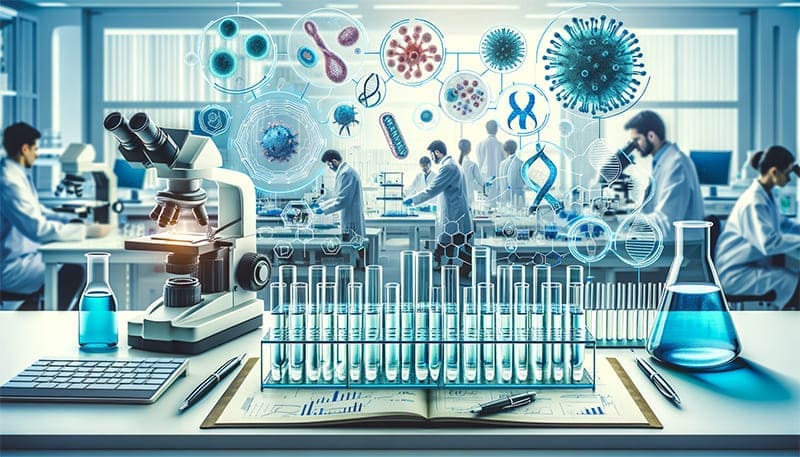
Test Tubes in Biological Experiments
In the dynamic field of biology, test tubes are indispensable in both fundamental and applied research. They facilitate a variety of biological experiments, from basic educational demonstrations to cutting-edge research in molecular biology and genetics.
Culturing Microorganisms
Test tubes are frequently used for culturing microorganisms. Biologists grow bacteria, fungi, and algae in nutrient-rich media within test tubes. This controlled environment allows for the study of growth patterns, genetic behaviors, and the effects of drugs on these organisms.
DNA and RNA Studies
In genetics, test tubes are critical for DNA and RNA extraction and purification processes. They provide a controlled environment for Polymerase Chain Reaction (PCR), a technique used to amplify DNA sequences, and for other molecular biology techniques like gel electrophoresis.
Enzyme Reactions
Biologists often use test tubes to study enzyme reactions. By adding substrates to enzymes in a test tube, researchers can observe reaction rates, effects of inhibitors, and other kinetic properties. This is vital in understanding metabolic processes and for drug development.
Cell and Tissue Studies
Test tubes also play a role in cell and tissue studies. They are used for preparing cell suspensions, conducting cell viability tests, and for tissue processing in histological studies. These applications are crucial in fields like oncology, immunology, and developmental biology.
Hormone and Protein Analysis
In endocrinology and biochemistry, test tubes are used for hormone assays and protein analysis. They facilitate the study of hormonal responses under various conditions and are essential in understanding protein interactions, structure, and function.
Environmental Sampling
Biologists also use test tubes for environmental sampling, such as collecting water samples for microbial analysis or air samples for pollen studies. This helps in monitoring environmental health and in studying the impact of pollutants on ecosystems.
The application of test tubes in biological experiments is vast and diverse. They are not just simple containers, but rather tools that enable scientists to delve into the complexities of life at a cellular and molecular level. In every biology lab, test tubes stand as silent yet significant contributors to our understanding of the living world.
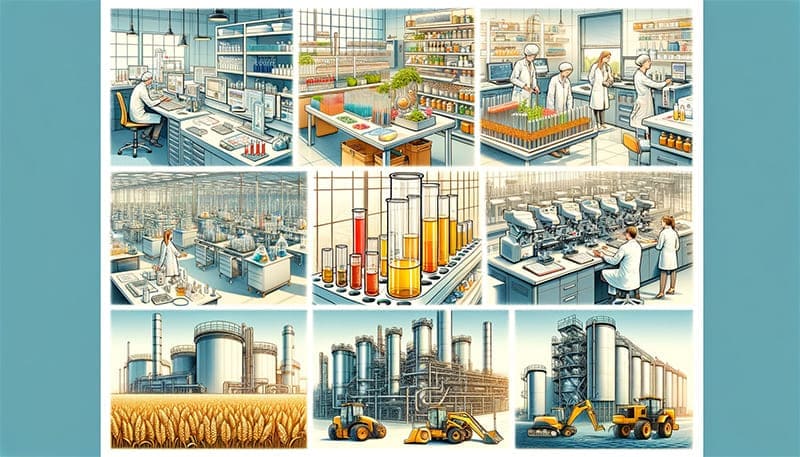
Applications of Test Tubes in Various Industries
Beyond the realms of academic and medical research, test tubes have found a wide range of applications in various industries, underscoring their versatility and importance in practical and commercial settings.
Food and Beverage Industry
In the food and beverage industry, test tubes are crucial for quality control and development of new products. They are used for testing chemical properties, such as pH levels and preservative effectiveness, and for sensory evaluations like flavor and aroma analysis. This ensures that the products meet safety standards and consumer expectations.
Cosmetics and Personal Care
In the cosmetics and personal care industry, test tubes play a significant role in product formulation and testing. They are used for stability tests, ingredient mixing, and efficacy tests of skincare and makeup products. This is essential for creating safe and effective consumer products.
Environmental Testing
Test tubes are also used extensively in environmental testing laboratories. They are employed in water analysis, soil testing, and air quality assessments, helping to monitor and manage environmental health and compliance with regulatory standards.
Oil and Gas Industry
In the oil and gas industry, test tubes are used for analyzing crude oil and natural gas compositions. They assist in determining the presence of various compounds and help in the quality assessment of fuels.
Agriculture
In agriculture, test tubes aid in soil nutrient analysis and in testing the effectiveness of fertilizers and pesticides. They also play a role in the study of plant diseases and in the development of genetically modified crops.
Forensic Science
In forensic science, test tubes are essential for analyzing evidence such as bodily fluids, fibers, and chemicals. They are key in DNA analysis, toxicology tests, and in identifying substances in criminal investigations.
The diverse applications of test tubes in different industries highlight their indispensable role in a wide array of fields. From ensuring food safety to aiding in criminal investigations, the humble test tube continues to be a vital tool in scientific and industrial progress.
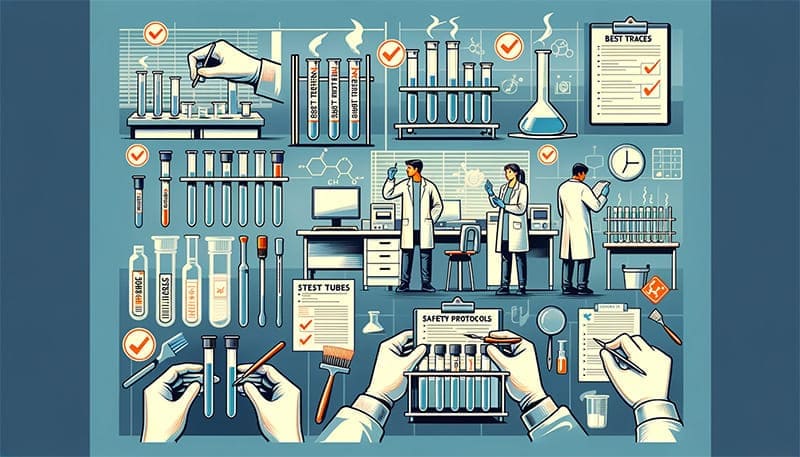
Safety Protocols and Best Practices in Handling Test Tubes
While test tubes are fundamental in laboratories, it’s crucial to adhere to safety protocols and best practices to ensure safe and effective use, especially when dealing with high-temperature or high-pressure experiments. Here, we outline essential guidelines for handling, storage, cleaning, and disposal of test tubes.
Handling Test Tubes
- Use Proper Equipment: Always use test tube holders or tongs when handling hot test tubes. Avoid direct contact with skin to prevent burns.
- Careful Mixing: When mixing chemicals in a test tube, gently swirl or invert with a stopper. Vigorous shaking can lead to spills or breakage.
- Avoid Direct Flame: When heating, use a test tube clamp and heat the test tube evenly by moving it back and forth over the flame. Do not point the open end towards yourself or others.
Storage of Test Tubes
- Upright Position: Store test tubes in a test tube rack in an upright position to prevent spills and breakage.
- Label Clearly: Label test tubes clearly to avoid confusion and potential mix-ups of contents.
- Temperature-Controlled Environment: Store in a cool, dry place, away from direct sunlight or heat sources, to prevent damage to the test tubes and degradation of contents.
Cleaning Test Tubes
- Immediate Cleaning: Clean test tubes immediately after use to prevent residues from hardening, which can make them difficult to clean and potentially hazardous.
- Use Appropriate Cleaning Agents: Use detergents or cleaning agents suitable for the type of residue and test tube material.
- Brushes and Water Rinses: Use test tube brushes for thorough cleaning and rinse well with water. For glass test tubes, multiple rinses with distilled water may be necessary to remove all traces of detergent.
Disposal of Test Tubes
- Broken Glassware: Dispose of broken glass test tubes in designated sharps containers, not in regular trash bins.
- Chemical Contamination: If the test tube contained hazardous chemicals, follow your facility’s protocol for hazardous waste disposal.
- Recycling and Reuse: Consider recycling options for plastic test tubes and reuse or proper disposal for glass test tubes, adhering to environmental safety standards.
Safety with High-Temperature or High-Pressure Experiments
- Use Heat-Resistant Materials: For high-temperature experiments, use borosilicate glass test tubes, which can withstand thermal shock.
- Pressure Release: Ensure there is a way to safely release pressure in experiments that generate gas or involve high pressure.
- Shielding: Use protective barriers or shields to guard against potential explosions or shattering.
Adhering to these safety protocols and best practices ensures that test tubes are used effectively and safely, minimizing the risk of accidents and ensuring the integrity of experiments. Safety in the laboratory is paramount, and proper handling of equipment like test tubes is a critical component of maintaining a secure and efficient research environment.
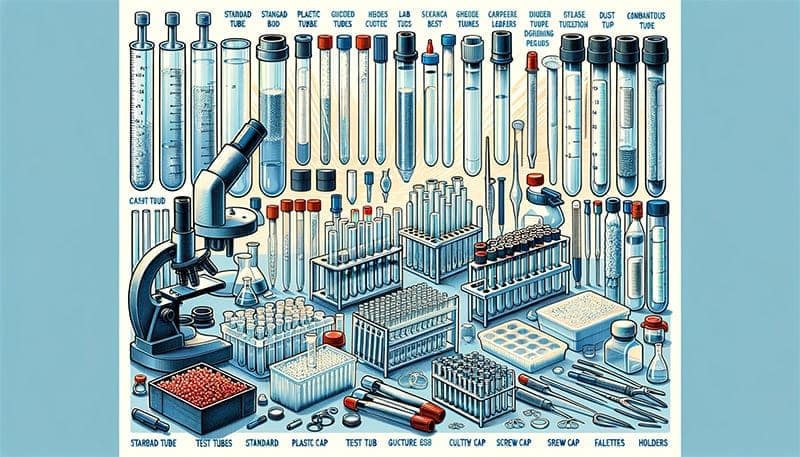
Comprehensive Overview of Test Tube Varieties and Best Practices
To delve deeper into the world of test tubes, it’s essential to understand the different types available, their material composition, applications, and the necessary precautions during use. For a more detailed exploration, you might find the resource at Glasswaree particularly informative. Here, we provide a summarized table for a quick overview:
| Type of Test Tube | Material | Common Applications | Usage Precautions |
|---|---|---|---|
| Standard Test Tube | Glass (Borosilicate) | General laboratory use, chemical reactions, heating substances | Handle gently to prevent breakage, use test tube holders for heating |
| Plastic Test Tube | Polypropylene, Polystyrene | Biological samples, centrifugation, temporary storage of chemicals | Avoid using with solvents or chemicals that can degrade plastic |
| Culture Tube | Glass, Plastic | Culturing microorganisms, tissue culture | Sterilize before and after use, especially in microbiological applications |
| Graduated Test Tube | Glass, Plastic | Measuring liquids, titration | Ensure accurate calibration, clean thoroughly before and after use |
| Screw Cap Test Tube | Glass, Plastic | Long-term storage of samples, transportation of biological material | Ensure caps are secure to prevent leaks, avoid cross-contamination |
| Centrifuge Tube | Polypropylene | Centrifugation processes, separation of substances | Check for compatibility with centrifuge, balance tubes properly during use |
| Falcon Tube | Polyethylene | Cell and tissue culture, sample storage | Use within temperature limits, handle with care to prevent contamination |
Understanding the different types of test tubes, their material properties, and appropriate usage is crucial for any scientific endeavor. Each type of test tube serves a specific purpose and requires certain precautions to ensure accurate results and safety in the laboratory. By familiarizing oneself with these aspects, researchers and technicians can effectively utilize test tubes in various experimental contexts.
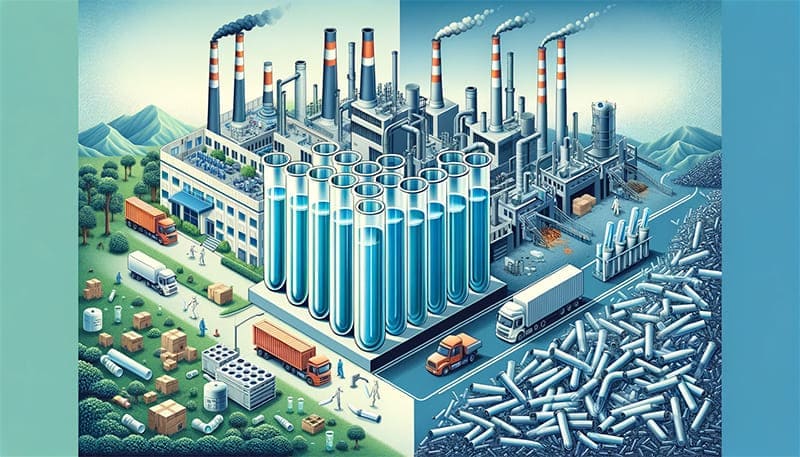
Economic and Environmental Impact of Test Tubes
The use of test tubes in research and industry not only has scientific implications but also significant economic and environmental impacts. Understanding these aspects helps in making informed decisions about their production, use, and disposal.
Economic Aspects of Test Tubes
- Cost-Effectiveness: Test tubes are relatively inexpensive to produce, especially plastic varieties. This cost-effectiveness makes them accessible for a wide range of scientific and industrial applications.
- Market Demand: The demand for test tubes is consistently strong, driven by their ubiquitous use in laboratories across various sectors, including healthcare, education, environmental testing, and pharmaceuticals.
- Innovation and Market Growth: Advances in test tube technology, such as the development of specialized tubes for specific applications, have opened new markets and opportunities for growth.
Environmental Impact of Test Tubes
- Sustainability Concerns: The production and disposal of test tubes, particularly plastic ones, raise sustainability concerns. The environmental impact of manufacturing processes and the accumulation of plastic waste are significant issues.
- Recycling Options: Glass test tubes offer better options for recycling and reusability compared to plastic. However, the recycling process requires energy and resources.
- Waste Management: Proper disposal and waste management of used test tubes, especially those contaminated with hazardous materials, are crucial to minimize environmental harm.
- Eco-Friendly Alternatives: The development of biodegradable plastics and the increased use of recyclable materials in test tube production are steps towards reducing environmental impact.
Balancing Economic and Environmental Factors
- Cost vs. Sustainability: While the low cost of plastic test tubes makes them economically appealing, their environmental impact encourages a shift towards more sustainable options like glass or biodegradable plastics.
- Investment in Green Technologies: Investing in technologies that reduce the environmental footprint of test tube production, such as energy-efficient manufacturing processes and eco-friendly materials, is becoming increasingly important.
- Educating Users: Raising awareness among users in research and industry about the environmental impact of test tubes and promoting responsible use and disposal practices.
The economic and environmental aspects of test tubes are closely intertwined. While they are economically beneficial and crucial for various industries, their environmental impact cannot be overlooked. Balancing cost-effectiveness with sustainability is key to ensuring that the use of test tubes aligns with environmental conservation goals while meeting the demands of scientific research and industrial applications.
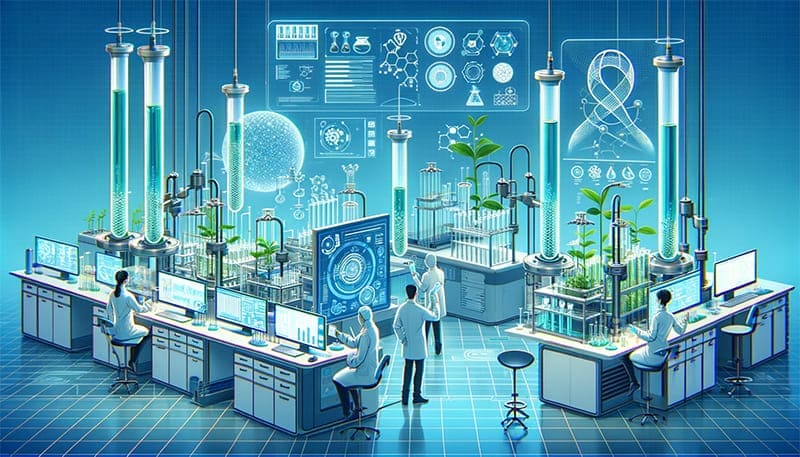
Future Trends in Test Tube Usage
As we look towards the future, the usage of test tubes in scientific research and industry is poised to evolve with emerging technologies and shifting priorities. Several key trends are likely to shape the landscape of test tube usage in the coming years.
Integration with Digital Technology
- Smart Test Tubes: We can expect to see the integration of digital technology with test tubes, such as embedded sensors and RFID tags for tracking and monitoring experiments in real time.
- Automated Handling: Automation in laboratories will become more prevalent, with robotic systems handling test tubes for high-throughput screening and analysis, enhancing efficiency and accuracy.
Advanced Materials
- New Materials: Research into new materials for test tubes, such as advanced polymers or composite materials, could provide enhanced properties like greater durability, chemical resistance, or biodegradability.
- Customized Test Tubes: Tailor-made test tubes designed for specific types of experiments or conditions, such as extreme temperatures or pressures, could become more common.
Environmental Sustainability
- Eco-Friendly Production: Increased focus on sustainable production methods for test tubes, aiming to reduce the carbon footprint and environmental impact.
- Biodegradable Options: Development of biodegradable test tubes to address plastic waste issues, particularly in disposable applications.
Medical and Diagnostic Advances
- Point-of-Care Testing: Test tubes designed for point-of-care medical testing, allowing for rapid diagnosis and treatment in various healthcare settings.
- Personalized Medicine: Test tubes that facilitate experiments in personalized medicine, such as those used in genetic testing or tailored drug efficacy studies.
Educational Outreach
- Educational Kits: Enhanced test tube kits for educational purposes, designed to engage students in science, technology, engineering, and mathematics (STEM) fields.
- Virtual Reality Integration: Combining test tube experiments with virtual reality (VR) and augmented reality (AR) for an immersive educational experience.
The future of test tube usage is dynamic and promising, with advancements in technology and a growing emphasis on sustainability and efficiency. These developments will not only enhance scientific research but also have far-reaching implications in education, industry, and healthcare. Test tubes, though small, are on the cusp of big changes, reflecting the ever-evolving nature of science and technology.
Conclusion
As we’ve journeyed through the remarkable world of test tubes, we’ve uncovered their profound impact on scientific advancement and daily life. These simple yet powerful tools are not just vessels for experiments; they are beacons of human curiosity and innovation. Now, as science continues to leap forward, let us embrace the evolving role of test tubes in unlocking the mysteries of our world and beyond. Join us in this continuous exploration, where every test tube holds the potential for discovery and every experiment brings us closer to understanding the universe we inhabit. Let’s keep questioning, experimenting, and learning – the future of science is in our hands.


